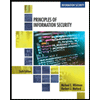
Essentials of MIS (12th Edition)
12th Edition
ISBN: 9780134238241
Author: Kenneth C. Laudon, Jane P. Laudon
Publisher: PEARSON
expand_more
expand_more
format_list_bulleted
Question
Chapter 8, Problem 1RQ
Program Plan Intro
System vulnerability:
- When huge data amounts are been kept in electronic form, it becomes susceptible to many threats.
- The information systems in many locations are been interconnected through communication networks.
- The unauthorized access can occur at many access points in network and is not limited to single location.
- The data flowing over networks could be accessed; valuable information could be stolen while transmission or data could be altered without authorization.
- The denial-of-service attacks are launched by intruders to disrupt website operations.
- Internets are vulnerable than internal networks as it is open to everyone.
Expert Solution
Explanation of Solution
Threats against contemporary information systems:
- The common threats against contemporary information systems are shown below:
-
o Technical threats:
- It includes unauthorized access and introducing errors.
-
o Communications:
- It includes tapping of conversations.
- Message alteration, radiation, fraud and theft.
- Denial of service attacks
-
o Corporate Systems:
- Theft of data
- Data copying
- Data Alteration
- Hardware failure
- Software failure
- Power failure
- Natural disasters.
-
o Poor management decisions:
- Poor design of safeguard
- It causes valuable data being lost or destroyed.
-
o Technical threats:
Explanation of Solution
Malware:
- A malware denotes a program that is harmful to a computer user.
- It includes viruses, worms, Trojan horses and spyware programs that gather information without user permission.
- Virus:
- o A program that would replicate itself by being copied.
- o It may initiate copying to another program, document or computer boot sector.
- Worm:
- o It denotes a virus that is self-replicating and does not alter files but resides in active memory.
- o It duplicates itself without human intervention.
- Trojan horse:
-
o A program in which malicious code is contained inside data or
programming that is harmless. - o It is not a virus as it does not replicate, but it denotes a way for other malicious code to be introduced into system.
-
o A program in which malicious code is contained inside data or
Explanation of Solution
Security problems created by hacker:
- A hacker denotes an individual who gains unauthorized access to computer system.
- It does so by finding security protection weakness in websites and computer systems.
- A hacker threatens
computer system security , steals information, damages systems and commits cyber vandalism. - They disrupt, deface or destroy a website or
information system intentionally.
Explanation of Solution
Computer crime with examples:
- A computer crime denotes any violations of criminal law that involves knowledge of computer technology for perpetration, investigation or prosecution.
- It is defined as commission of illegal acts through use of a computer or against computer system.
- The examples with computers as crime targets are shown below:
- o Confidentiality breach for protected computerized data.
- o Unauthorized access to computer systems.
- o Accessing protected computers for committing fraud.
- o Accessing protected computers for causing damage intentionally.
- o Transmission of a program that causes damage to protected computer.
- The examples with computers as instruments of crime are shown below:
- o Trade secrets theft.
- o Defraud schemes.
- o Using threatening mails.
- o Attempt to intercept electronic communication intentionally.
- o Illegal access of stored communications including voice mail and email.
- o Transmission of child pornography using computer.
Explanation of Solution
Identity theft and phishing:
- Identity theft denotes a crime in which personal information pieces are obtained.
- It includes social security number, license number or credit card number to act as behalf of someone else.
- The information might be used for obtaining credit, merchandise or services in name of victim.
- It is a big problem today as internet has made easy for identity thieves to use stolen information.
- The goods could be purchased online without any personal interaction.
- The e-commerce sites become sources for personal information that criminals uses to establish a new identity.
- Phishing denotes setting up fake websites or sending fake mails that look like those from legitimate business.
- It asks users for confidential personal data.
- The user may ask recipients to confirm records by providing social security numbers, credit card information and other personal details.
Explanation of Solution
Security and system reliability problems:
- The employees create financial threats to business. It includes destruction of e-commerce sites, diversion of credit data and personal information.
- Employees has access to privileged information and in presence of weak security procedures, they can check all personal details.
- The system compromise happens when an employee lets coworker use the system.
- Malicious intruders may trick employees into password revealing pretending to be legitimate company members.
- The faulty data could be entered by employees and can introduce errors.
- Information specialists can create software errors while designing and development of new software.
Explanation of Solution
Software defects affect system reliability and security:
- The software could fail to perform well or gives erroneous result because of undetected bugs.
- A control system may fail to carry messages or allow internet access.
- The customers may be wrongly charged due to such failures.
- The business may order more inventory than it requires.
- The bugs or defects caused by incorrect designs denote major quality problems.
- The maintenance of old programs that is caused by changes in organization,
system design flaws and software complexity denotes a problem. - The small bugs in middle of complex programs may create serious issues in testing.
Want to see more full solutions like this?
Subscribe now to access step-by-step solutions to millions of textbook problems written by subject matter experts!
Students have asked these similar questions
The assignment here is to write an app using a database named CIT321 with a collection named
students; we will provide a CSV file of the data. You need to use Vue.js to display 2 pages. You should
know that this assignment is similar, all too similar in fact, to the cars4sale2 example in the lecture notes
for Vue.js 2. You should study that program first. If you figure out cars4sale2, then program 6 will be
extremely straightforward. It is not my intent do drop a ton of new material here in the last few days of
class.
The database contains 51 documents. The first rows of the CSV file look like this:
sid
last_name
1 Astaire
first_name
Humphrey CIT
major
hrs_attempted
gpa_points
10
34
2
Bacall
Katharine EET
40
128
3 Bergman
Bette
EET
42
97
4
Bogart
Cary
CIT
11
33
5 Brando
James
WEB
59
183
6 Cagney
Marlon
CIT
13
40
GPA is calculated as gpa_points divided by hrs_attempted. GPA points would have been arrived at by
adding 4 points for each credit hour of A, 3 points for each credit hour of…
I need help to solve the following case, thank you
hi I would like to get help to resolve the following case
Chapter 8 Solutions
Essentials of MIS (12th Edition)
Knowledge Booster
Similar questions
- Could you help me to know features of the following concepts: - defragmenting. - dynamic disk. - hardware RAIDarrow_forwardwhat is a feature in the Windows Server Security Compliance Toolkit, thank you.arrow_forwardYou will write a program that allows the user to keep track of college locations and details about each location. To begin you will create a College python class that keeps track of the csollege's unique id number, name, address, phone number, maximum students, and average tuition cost. Once you have built the College class, you will write a program that stores College objects in a dictionary while using the College's unique id number as the key. The program should display a menu in this order that lets the user: 1) Add a new College 2) Look up a College 4) Delete an existing College 5) Change an existing College's name, address, phone number, maximum guests, and average tuition cost. 6) Exit the programarrow_forward
- Show all the workarrow_forwardShow all the workarrow_forward[5 marks] Give a recursive definition for the language anb2n where n = 1, 2, 3, ... over the alphabet Ó={a, b}. 2) [12 marks] Consider the following languages over the alphabet ={a ,b}, (i) The language of all words that begin and end an a (ii) The language where every a in a word is immediately followed by at least one b. (a) Express each as a Regular Expression (b) Draw an FA for each language (c) For Language (i), draw a TG using at most 3 states (d) For Language (ii), construct a CFG.arrow_forward
- Question 1 Generate a random sample of standard lognormal data (rlnorm()) for sample size n = 100. Construct histogram estimates of density for this sample using Sturges’ Rule, Scott’s Normal Reference Rule, and the FD Rule. Question 2 Construct a frequency polygon density estimate for the sample in Question 1, using bin width determined by Sturges’ Rule.arrow_forwardGenerate a random sample of standard lognormal data (rlnorm()) for sample size n = 100. Construct histogram estimates of density for this sample using Sturges’ Rule, Scott’s Normal Reference Rule, and the FD Rule.arrow_forwardCan I get help with this case please, thank youarrow_forward
arrow_back_ios
SEE MORE QUESTIONS
arrow_forward_ios
Recommended textbooks for you
 Fundamentals of Information SystemsComputer ScienceISBN:9781337097536Author:Ralph Stair, George ReynoldsPublisher:Cengage Learning
Fundamentals of Information SystemsComputer ScienceISBN:9781337097536Author:Ralph Stair, George ReynoldsPublisher:Cengage Learning Management Of Information SecurityComputer ScienceISBN:9781337405713Author:WHITMAN, Michael.Publisher:Cengage Learning,
Management Of Information SecurityComputer ScienceISBN:9781337405713Author:WHITMAN, Michael.Publisher:Cengage Learning, Principles of Information Security (MindTap Cours...Computer ScienceISBN:9781337102063Author:Michael E. Whitman, Herbert J. MattordPublisher:Cengage Learning
Principles of Information Security (MindTap Cours...Computer ScienceISBN:9781337102063Author:Michael E. Whitman, Herbert J. MattordPublisher:Cengage Learning Fundamentals of Information SystemsComputer ScienceISBN:9781305082168Author:Ralph Stair, George ReynoldsPublisher:Cengage Learning
Fundamentals of Information SystemsComputer ScienceISBN:9781305082168Author:Ralph Stair, George ReynoldsPublisher:Cengage Learning Principles of Information Systems (MindTap Course...Computer ScienceISBN:9781285867168Author:Ralph Stair, George ReynoldsPublisher:Cengage Learning
Principles of Information Systems (MindTap Course...Computer ScienceISBN:9781285867168Author:Ralph Stair, George ReynoldsPublisher:Cengage Learning

Fundamentals of Information Systems
Computer Science
ISBN:9781337097536
Author:Ralph Stair, George Reynolds
Publisher:Cengage Learning

Management Of Information Security
Computer Science
ISBN:9781337405713
Author:WHITMAN, Michael.
Publisher:Cengage Learning,

Principles of Information Security (MindTap Cours...
Computer Science
ISBN:9781337102063
Author:Michael E. Whitman, Herbert J. Mattord
Publisher:Cengage Learning

Fundamentals of Information Systems
Computer Science
ISBN:9781305082168
Author:Ralph Stair, George Reynolds
Publisher:Cengage Learning


Principles of Information Systems (MindTap Course...
Computer Science
ISBN:9781285867168
Author:Ralph Stair, George Reynolds
Publisher:Cengage Learning